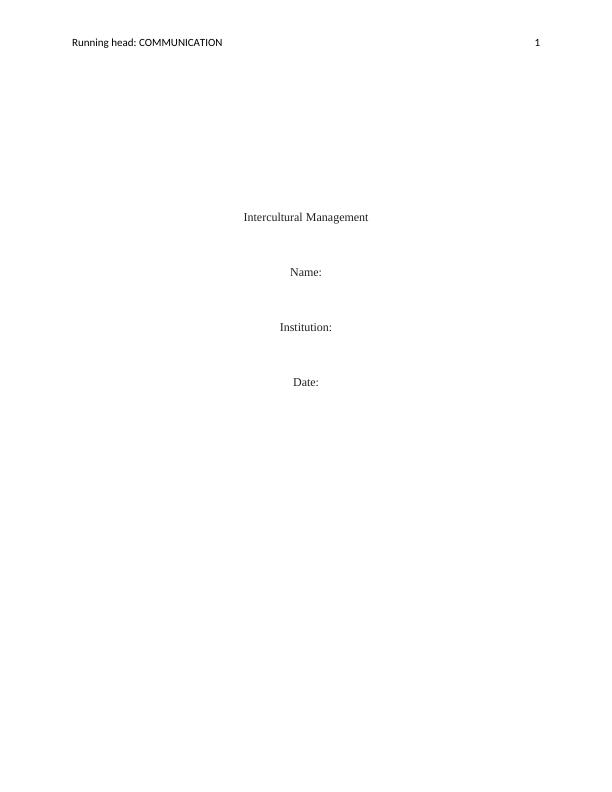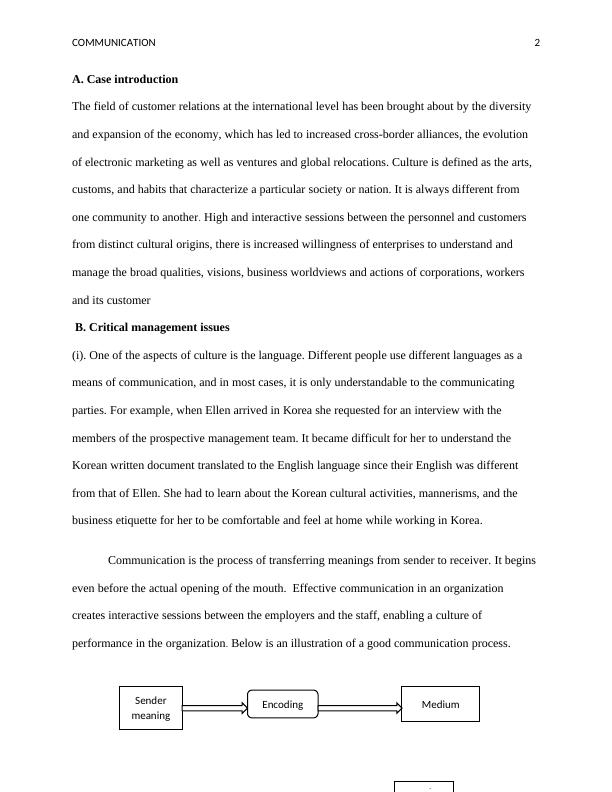Intercultural Management
Added on 2020-03-07
6 Pages1202 Words453 Views
Running head: COMMUNICATION1Intercultural ManagementName:Institution:Date:

COMMUNICATION2A. Case introductionThe field of customer relations at the international level has been brought about by the diversity and expansion of the economy, which has led to increased cross-border alliances, the evolution of electronic marketing as well as ventures and global relocations. Culture is defined as the arts, customs, and habits that characterize a particular society or nation. It is always different from one community to another. High and interactive sessions between the personnel and customers from distinct cultural origins, there is increased willingness of enterprises to understand and manage the broad qualities, visions, business worldviews and actions of corporations, workers and its customer B. Critical management issues(i). One of the aspects of culture is the language. Different people use different languages as a means of communication, and in most cases, it is only understandable to the communicating parties. For example, when Ellen arrived in Korea she requested for an interview with the members of the prospective management team. It became difficult for her to understand the Korean written document translated to the English language since their English was different from that of Ellen. She had to learn about the Korean cultural activities, mannerisms, and the business etiquette for her to be comfortable and feel at home while working in Korea. Communication is the process of transferring meanings from sender to receiver. It begins even before the actual opening of the mouth. Effective communication in an organization creates interactive sessions between the employers and the staff, enabling a culture of performance in the organization. Below is an illustration of a good communication process. SendermeaningMeetingMediumEncoding

COMMUNICATION3 Feedback?There are also different styles of verbal communication which include contextual and personal styles, indirect and direct, elaborate, succinct and exacting and finally the affective and instrumental styles. (ii). To undertake an effective intercultural management in various organizations, there is need toenhance cultural views on business structures. Structures consist of the arrangement and hierarchy of staff in the organization, distribution of powers from the top management to the bottom part where we have the employees. Proper coordination and recognition of these structures have great impacts in any given organization.(iii). Eating habit and specification is also an essential part of the culture. One will notice a change in what and the way other people far from their locality eat and the time of eating too. There are both acceptable and unacceptable meals regardless of their edibility depending on different cultures. For example, one society’s favorite meal may be a ‘poison’ for another community. In Korea, Ellen found that attending lunch was not optional as it was in America. Lunch with the team was an important daily event where everybody was expected to attend without hesitation. The foods, drinks, and songs sang after work was not familiar with her thus she had the obligation to train herself about these new things.(iv). There are also noticeable differences when it comes to management of teams in various organizations. Each organization believes that the way they manage their staff, though differentlyfrom others, determines the overall output at long last. Team building and effective interactions Receiverinterpretation Decoding

End of preview
Want to access all the pages? Upload your documents or become a member.
Related Documents
3004IBA - Intercultural Management - Individual Reportlg...
|6
|1521
|35
Client Approaches Adopted by Ellen and Jack | Essaylg...
|5
|1011
|48
Describe the Barriers in Workinglg...
|6
|1271
|27
Need help with writing a case Study Analysis - Assignmentlg...
|4
|708
|12
